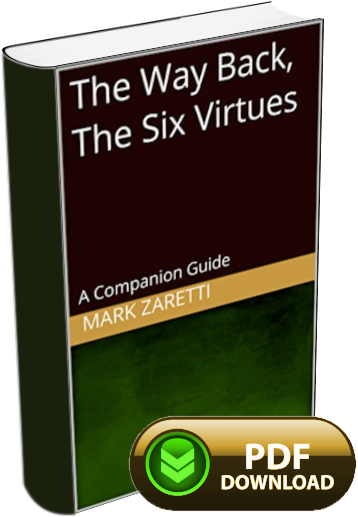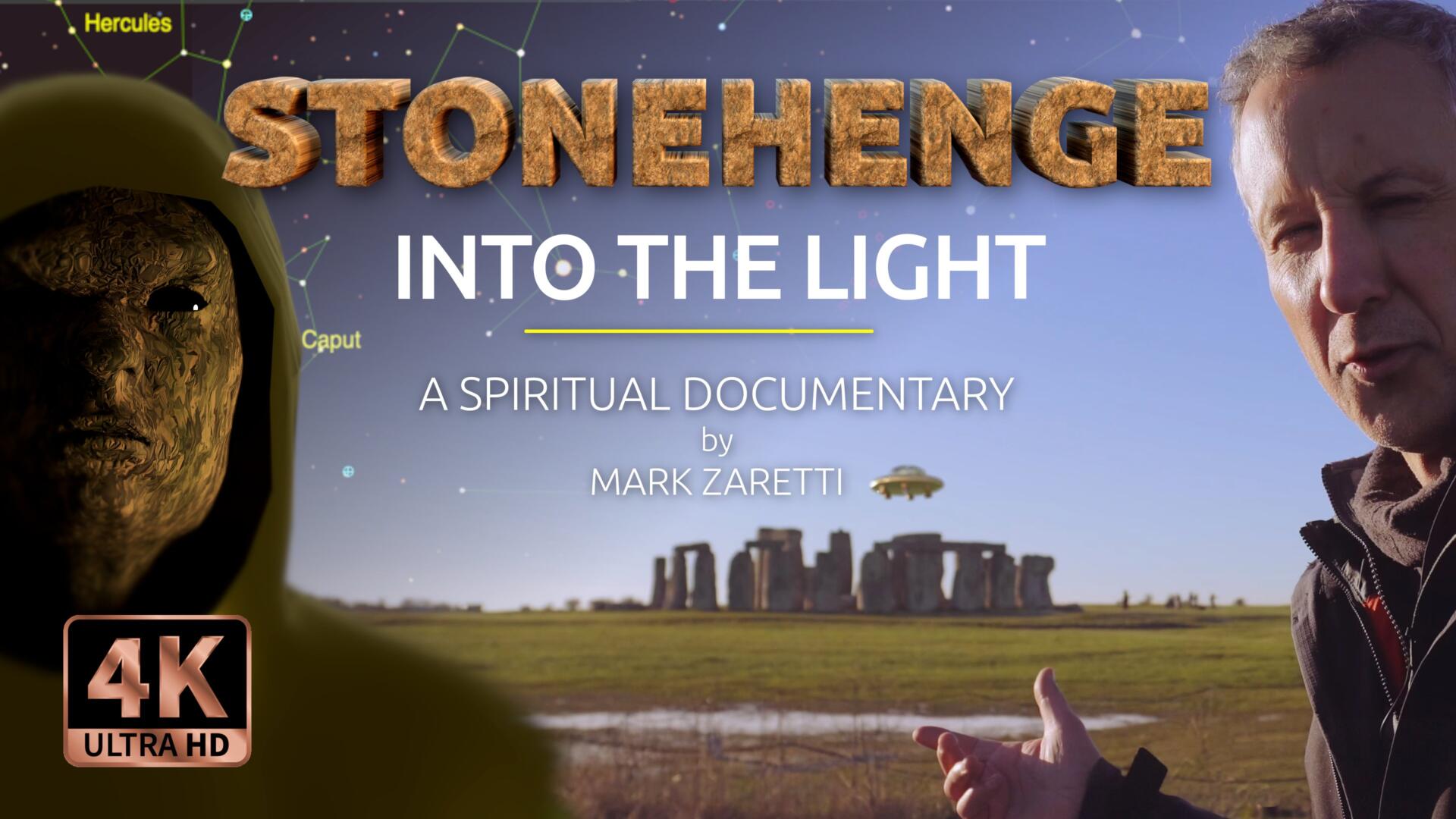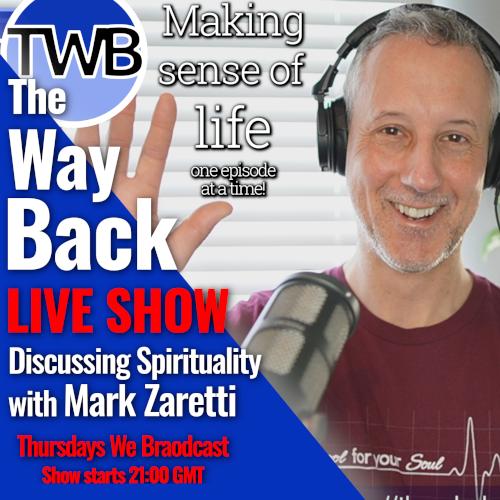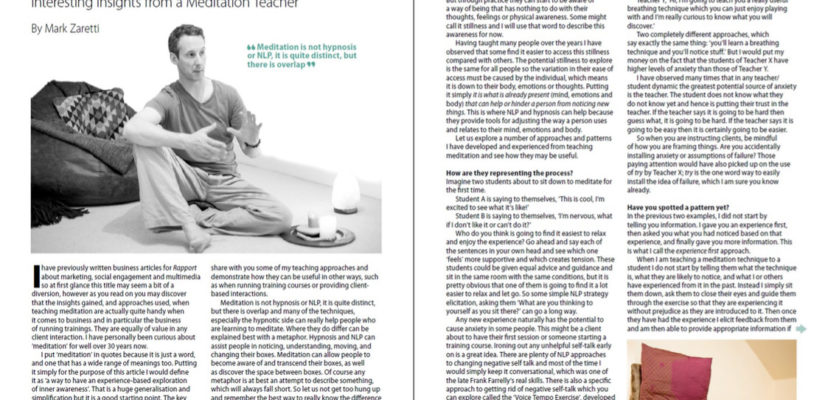
Rapport Article, March 2015
In March 2015 Mark wrote and published and article in Rapport Magazine UK explaining some of his teaching approaches making it easy to learn meditation for anyone including beginners.
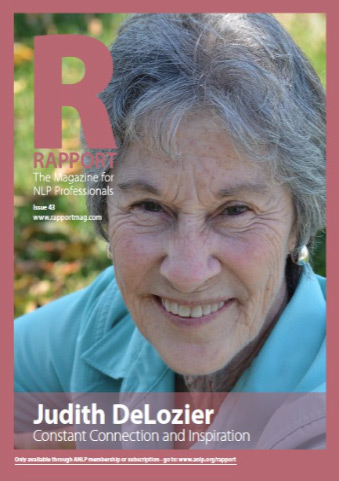
Boost the Effectiveness of Your Training Courses and Client Sessions with Interesting Insights from a Mediation Teacher.
I have previously written business articles for Rapport about marketing, social engagement and multimedia so at first glance this title may seem a bit of a diversion, however as you read on you may discover that the insights gained, and approaches used, when teaching meditation are actually quite handy when it comes to business and in particular the business of running trainings. They are equally of value in any client interaction. I have personally been curious about “meditation” for well over 30 years now. I put “meditation” in quotes because it is just a word, and one that has a wide range of meanings too. Putting it simply for the purpose of this article I would define it as “a way to have an experience-based exploration of inner awareness”. That is a huge generalisation and simplification but it is a good starting point. The key words here are “experience based” and “awareness“.
As well as enjoying the many benefits and insights meditation practice can bring, I have also been teaching it since the late nineties and have run many courses, lectures, private lessons, classes and even teach people in many countries via Skype. So with the keywords of “experience based” and “awareness” in mind let me share with you some of my teaching approaches and demonstrate how they can be useful in other ways, such as when running training courses or providing client based interactions. But wait, before we dive right in here is a little more about my background. I have trained in NLP to a master practitioner level and was an assistant for a number of years assisting NLP Trainers running training courses in the UK. I have also trained with the excellent Doug O’Brien in Eriksonian Hypnosis and “Sleight of Mouth” language patterns, had the pleasure of training multiple times with the late Frank Farrelly and a number of other trainers, voice coaches and teachers.
Meditation is not hypnosis or NLP, it is quite distinct, but there is overlap and many of the techniques, especially the hypnotic side can really help people who are learning to meditate. Where they do differ can be explained best with a metaphor. Hypnosis and NLP can assist people in noticing, understanding, moving, and changing their boxes. Meditation can allow people to become aware of and transcend their boxes, as well as discover the space between boxes. Of course any metaphor is at best an attempt to describe something, which will always fall short. So let us not get too hung up and remember the best way to really know the difference is to explore both, and that is something I have done and wish to share with you.
So let us understand better what a person might experience when learning meditation so we can understand how NLP and hypnosis fit in and vice versa. When people start meditation they are learning how to be aware internally. This awareness starts by being aware of what is already present, which is of course their physical body, their emotions and their thoughts. But through practice they can start to be aware of a way of being that has nothing to do with their thoughts, feelings or physical awareness. Some might call it stillness and I will use that word to describe this awareness for now. Having taught many people over the years I have observed that some find it easier to access this stillness compared to others. The potential stillness to explore is the same for all people so the variation in their ease of access must be caused by the individual, which means it is down to their body, emotions or thoughts. Putting it simply it is what is already present (mind, emotions and body) that can help or hinder a person from noticing new things. This is where NLP and hypnosis can help because they provide tools for adjusting the way a person uses and relates to their mind, emotions and body.
Let us explore a number of approaches and patterns I have developed and experienced from teaching meditation and see how they may be useful.
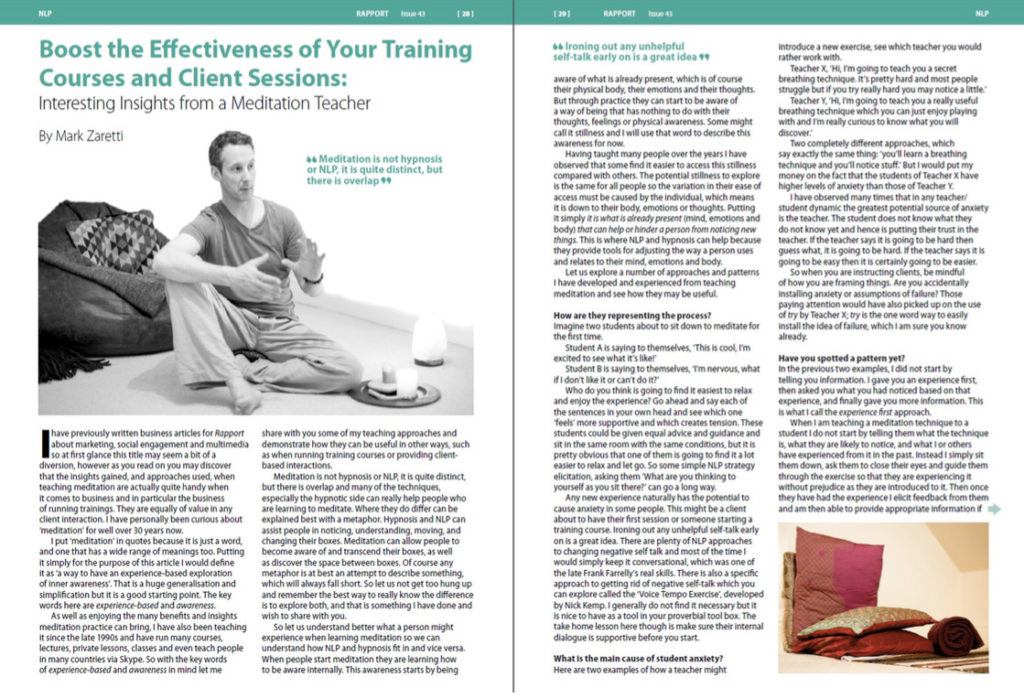
How Are They Representing The Process?
Imagine two students about to sit down to meditate for the first time.
Student A is saying to themselves “This is cool, I’m excited to see what it’s like!”.
Student B is saying to themselves “I’m nervous, what if I don’t like it or can’t do it?”.
Who do you think is going to find it easiest to relax and enjoy the experience? Go ahead and say each of the sentences in your own head and see which one “feels” more supportive and which creates tension. These students could be given equal advice and guidance and sit in the same room with the same conditions, but it is pretty obvious that one of them is going to find it a lot easier to relax and let go. So some simple NLP strategy elicitation, asking them “What are you thinking to yourself as you sit there?” can go a long way. Any new experience naturally has the potential to cause anxiety in some people. This might be a client about to have their first session or someone starting a training course. Ironing out any unhelpful self-talk early on is a great idea. There are plenty of NLP approaches to changing negative self-talk and most of the time I would simply keep it conversational, which was one of the late Frank Farrelly’s real skills. There is also a specific approach to getting rid of negative self-talk which you can explore called the “Voice Tempo Exercise”, developed by Nick Kemp. I generally do not find it necessary but it is nice to have as a tool in your proverbial tool box. The take home lesson here though is make sure their internal dialogue is supportive before you start.
What is the Main Cause of Student Anxiety?
Here are two examples of how a teacher might introduce a new exercise, see which teacher you would rather work with.
Teacher X: “Hi, I’m going to teach you a secret breathing technique. It’s pretty hard and most people struggle but if you try really hard you may notice a little.”
Teacher Y: “Hi, I’m going to teach you a really useful breathing technique which you can just enjoy playing with and I’m really curious to know what you will discover.”
Two completely different approaches, which say exactly the same thing: “you’ll learn a breathing technique and you’ll notice stuff”. But I would put my money on the fact that the students of Teacher X have higher levels of anxiety than those of Teacher Y. I have observed many times that in any teacher/student dynamic the greatest potential source of anxiety is the teacher. The student does not know what they do not know yet and hence is putting their trust in the teacher. If the teacher says it is going to be hard then guess what, it is going to be hard. If the teacher says it is going to be easy then it is certainly going to be easier. So when you are instructing clients, be mindful of how are you framing things. Are you accidentally installing anxiety or assumptions of failure? Those paying attention would have also picked up on the use of “try” in Teacher A’s speech, “try” is the one word way to easily install the idea of failure, which I am sure you know already.
Have You Spotted a Pattern Yet?
In the previous two examples, I did not start by telling you information. I gave you an experience first, then asked you what you had noticed based on that experience, and finally gave you more information. This is what I call the “experience first” approach. When I am teaching a meditation technique to a student I do not start by telling them what the technique is, what they are likely to notice, and what I or others have experienced from it in the past. Instead I simply sit them down, ask them to close their eyes and guide them through the exercise so that they are experiencing it without prejudice as they are introduced to it. Then once they have had the experience I elicit feedback from them and am then able to provide appropriate information if needed. This approach has several benefits:
- Because I have not provided lots of information it means there is less information with which they can create expectations and hence potential blocks.
- With fewer expectations about what they may experience it also means they are more likely to notice what they are actually experiencing rather than filtering only for those aspects which match their anticipated expectations.
- Because they have had an experience first and I have elicited information about it I now am in a position to make sure any information I provide is actually related to their experience and hence has more value.
For me, this is also one of the nice things about meditation, the fact it is not an information based pursuit. Let me demonstrate. I am sure you have probably seen a helicopter. Now even if you had read every book there is on helicopters, looked at lots of pictures and videos, studied them at length, all this information would not be the same as actually having the experience of flying in one. So when I teach, I am mindful of the difference between information and experience. Mainly that information is how we communicate our awareness of an experience with others (and ourselves). The experience comes first. You cannot be the source of new information without first having had a new experience. So when teaching meditation my goal is to enable experience and then provide information relevant to the experience, rather than tying to provide information about a potential experience. So how would you provide the “experience first” approach in your work to improve your clients experience?
Using NLP Submodalities
In the above example I said that I would elicit information from the person after they had the experience. An awareness of submodalities (Visual, Auditory, Kinaesthetic – VAK etc.) and how they are used in questions can really help in this elicitation stage. What I normally ask the person after a meditation is “what did you notice this particular time?”. You’ll find that there are no submodality references in that statement. I could have phrased it visually and said “what did you see this particular time?” or phrased it kinaesthetically “how did that feel this particular time?”. But by avoiding submodalities I avoid limiting their range of response. The word “notice” allows them to include all submodalities in their response. Equally if I want to filter for just one submodality then I will specifically use words corresponding to that submodality.
It is Time We Talked About Time.
Everything happens in time and most of the time, we are either thinking about the future, remembering the past, or occasionally we are in the present. Of course we use this to great effect in NLP for timeline work. In any training, change work, therapy session, coaching and of course meditation training there are subtle aspects of time and how as a teacher, or therapist we reference time can have a strong influence on our students/clients. Any process happens over a period of time and the expectation of how long it might take is often dictated by the experience and expectations of the teacher. For example if I told my students it will take you 10 years to be ready for the next phase then that would create a certain (unhelpful?) expectation in them, especially when you consider the assumption that difficulty and time are associated. Over my many years of teaching I have learned that very little is actually set in stone. It may have taken some people 10 years to achieve a certain awareness but does that actually mean that is a truism for everyone? I tend to avoid setting expectations of time when when teaching. That way the possibility for faster change is always present.
I do not avoid the subject of time completely though. Often at the end of a lesson I may use the concept of timelines to help students create the supportive habit of regular meditation. For example at the end a guided meditation when the students are really relaxed I might say something like “as you think about the future you can imagine times when it would be useful to feel this relaxed and able to keep focused. So it is nice to know you can use these meditation techniques whenever you need”. What a statement like this does is allows them to create the assumption that they will use what they have learned now in the future. It also allows them to anticipate the benefits of doing so. Both of which are obviously useful to helping the person learn to meditate. So when you think about your client interactions in the future, how would you use references to time differently to improve the results you get?
Let Us Go From One Extreme To Another
When you close your eyes for about 10 seconds what do you notice? OK give it a go BEFORE READING THE NEXT PART.
OK so I am going to demonstrate another useful approach you can take but if you did not just close your eyes and notice whatever you noticed for at least 10 seconds then give it another go NOW.
OK so just read this next paragraph and hear it in your head as if I was saying there with you.
“When people have their eyes closed some will notice colours while others will notice that there are no colours. Some will notice that everything is still while others will notice that there is movement. Some will notice that things seem flat while others will notice that there is a sense of depth. Some will notice that there is a space in front of them and others will notice that there is nothing in front of them. Some will notice their thoughts and others will notice the space between their thoughts.”
Now close your eyes for about 10 seconds and notice what you notice, and notice what is different from the last time you closed your eyes.
Some people will have noticed that what they noticed was different and other people would have noticed that everything was the same. What did you notice this particular time? In the paragraph above what I did was to introduce polar opposites, for example “some people will see colour and others will see that there is no colour.” What this does is make the entire range of experience between those polar opposites accessible to the person without prejudice. They may notice colour (some people do at certain stages of meditation) or they may not, but either way it is within the range of experiences defined by the polar opposites and so whatever they notice is fine. It is a subtle way of saying “you may notice XXX”, but if they do not notice XXX then they do not feel that they have failed in any way. Notice as well that the language was third person, “some people notice” rather than “you may notice”. This is a way of introducing a suggestion without creating pressure on the person. For example in a client therapy session you might say something like “Some clients notice changes right away while others notice the difference some time later”, either way you are suggesting change will happen along with the possibility that it could happen quickly. Some people will be able to think of lots of ways this may be useful in the future, while other people may not think of any ways and that is OK.
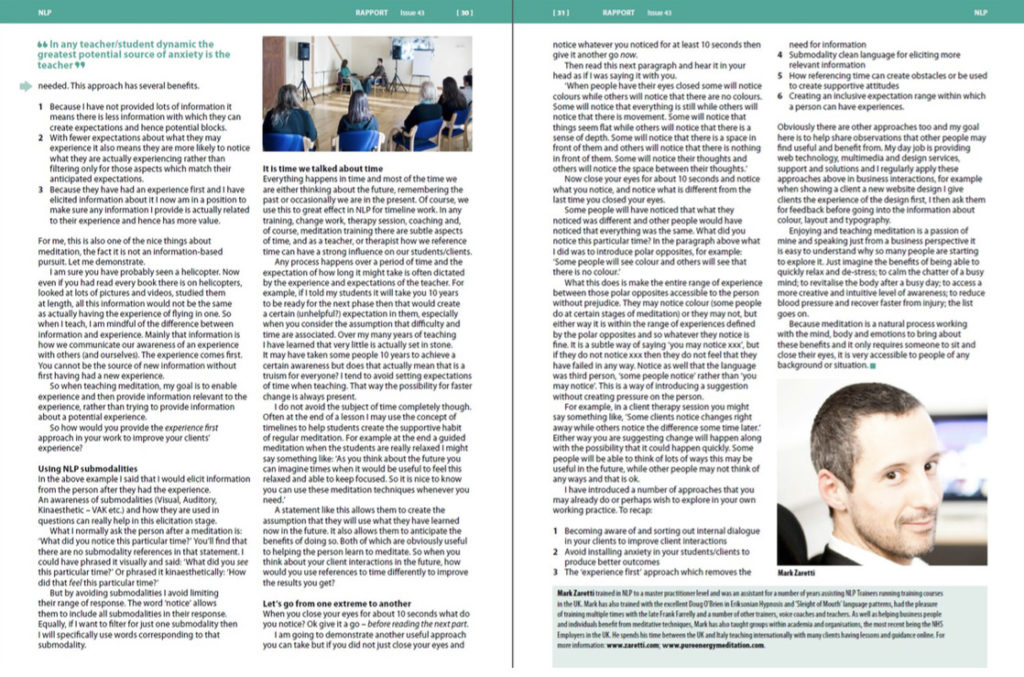
I have introduced a number of approaches that you may already do or perhaps wish to explore in your own working practice. To recap:
- Becoming aware of and sorting out internal dialogue in your clients to improve client interactions.
- Avoid installing anxiety in your students/clients to produce better outcomes.
- The “experience first” approach which removes the need for information.
- Submodality clean language for eliciting more relevant information.
- How referencing time can create obstacles or be used to create supportive attitudes.
- Creating an inclusive expectation range within which a person can have experiences.
Obviously there are other approaches too and my goal here is to help share observations that other people may find useful and benefit from. My day job (www.zaretti.com) is providing web technology, multimedia and design services, support and solutions and I regularly apply these approaches above in business interactions, for example when showing a client a new website design I give clients the experience of the design first, I then ask them for feedback before going into the information about colour, layout and typography. Enjoying and teaching meditation is a passion of mine (www.pureenergymeditation.com) and speaking just from a business perspective it is easy to understand why so many people are starting to explore it. Just imagine the benefits of being able to quickly relax and de-stress; to calm the chatter of a busy mind; to revitalise the body after a busy day; to access a more creative and intuitive level of awareness; to reduce blood pressure and recover faster from injury; the list goes on. Because meditation is a natural process working with the mind body and emotions to bring about these benefits and it only requires someone to sit and close their eyes it is very accessible to people of any background or situation. As well as helping business people and individuals benefit from meditative techniques I have also taught groups within academia and organisations, the most recent being The NHS Employers in the UK. I spend my time between the UK and Italy and teach internationally with many clients having lessons and guidance online.
Mark Zaretti

